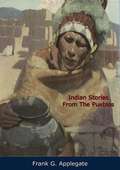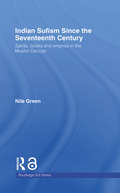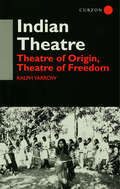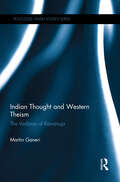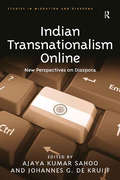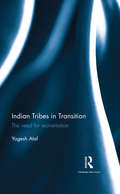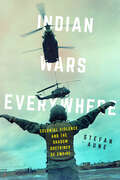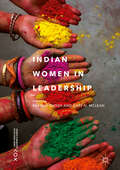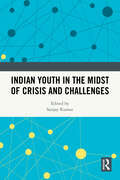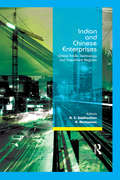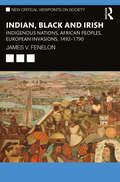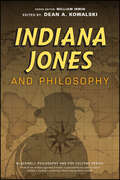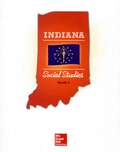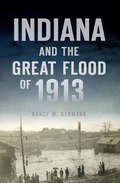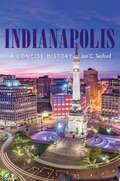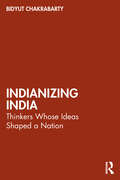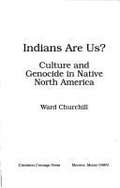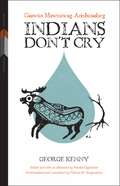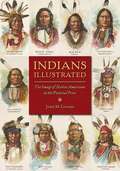- Table View
- List View
Indian Stories From The Pueblos: Tales Of New Mexico And Arizona (Beautiful Rio Grande Classics Ser.)
by Frank G. ApplegateIndian Stories from the Pueblos is a combination of tales of early Pueblo days and stories from 1929, when the book was first published. They were written by Frank Applegate, a New Mexican artist who lived among the Pueblos.Contains beautiful illustrations from original Pueblo Indian paintings and a foreword by Witter Bynner.
Indian Sufism since the Seventeenth Century: Saints, Books and Empires in the Muslim Deccan (Routledge Sufi Series #Vol. 18)
by Nile GreenSufism is often regarded as standing mystically aloof from its wider cultural settings. By turning this perspective on its head, Indian Sufism since the Seventeenth Century reveals the politics and poetry of Indian Sufism through the study of Islamic sainthood in the midst of a cosmopolitan Indian society comprising migrants, soldiers, litterateurs and princes. Placing the mystical traditions of Indian Islam within their cultural contexts, this interesting study focuses on the shrines of four Sufi saints in the neglected Deccan region and their changing roles under the rule of the Mughals, the Nizams of Haydarabad and, after 1948, the Indian nation. In particular Green studies the city of Awrangabad, examining the vibrant intellectual and cultural history of this city as part of the independent state of Haydarabad. He employs a combination of historical texts and anthropological fieldwork, which provide a fresh perspective on developments of devotional Islam in South Asia over the past three centuries, giving a fuller understanding of Sufism and Muslim saints in South Asia.
Indian Theatre: Theatre of Origin, Theatre of Freedom
by Ralph YarrowThis book sets out from the question: why have so many western theatre workers come to India and what were they looking for? What is it that seemed to be lacking in western performance and understanding of the nature and function of theatre? Locating Indian theatre as a major site of reappraisal and renewal both in India and in the world of perform
Indian Thought and Western Theism: The Vedānta of Rāmānuja (Routledge Hindu Studies Series)
by Martin GaneriThe encounter between the West and India in the modern period has also been an encounter between Western modernity and the traditions of classical Indian thought. This book is the study of one aspect this encounter, that between Western scholasticism and one classical Indian tradition of religious thought and practice: the Vedānta. In the modern period there have been many attempts to relate Western theistic traditions to classical Indian accounts of ultimate reality and the world. Parallels have usually been drawn with modern forms of Western philosophy or modern trends in theism. Modern Indological studies have continued to make substantial use of Western terms and concepts to describe and analyse Indian thought. A much-neglected area of study has been the relationship between Western scholastic theology and classical Indian thought. This book challenges existing parallels with modern philosophy of religion and forms of theism. It argues instead that there is an affinity between scholasticism and classical Indian traditions. It considers the thought of Rāmānuja (traditional dates 1017-1137 CE), who developed an influential theist and realist form of Vedānta, and considers how this relates to that of the most influential of Western scholastics, Thomas Aquinas (1224/5-1274 CE). Within what remain very different traditions we can see similar methods of enquiry, as well as common questions and concerns in their accounts of ultimate reality and of the world. Arguing that there is indeed an affinity between the Western scholastic tradition and that of classical Indian thought, and suggesting a reversal of the tendencies of earlier interpretations, this book will be of interest to students and scholars of Asian religion, Hinduism and Indian philosophy.
Indian Transnationalism Online: New Perspectives on Diaspora (Studies in Migration and Diaspora)
by Ajaya Kumar Sahoo Johannes G. KruijfPresent-day migration takes place in a world characterized by the compression of time and space, with cheaper air travel and the existence of new communication technologies - the internet in particular - making it easier to stay in contact with the places, people and cultures that one has left. This book investigates the online organization of, and exchanges within, the global Indian diaspora. Bringing together research from around the world and presenting studies drawn from the US, Europe and India, it engages with theoretical and methodological debates concerning the shaping and transformation of migrant culture in emerging sites of sociality, and explores issues such as religion, citizenship, nationalism, region and caste as they relate to Indian identity in global, transnational contexts. With detailed empirical case studies showing both how members of the Indian diaspora connect with one other and ’life at home’ and how institutions in India maintain such links, Indian Transnationalism Online sheds light on the ways in which information and communication technology functions as both a catalyst and indicator of contemporary socio-cultural change. As such it will be of interest to sociologists, anthropologists, political scientists and studies of cultural studies working in the areas of migration, transnationalism and ethnic studies.
Indian Tribes in Transition: The need for reorientation
by Yogesh AtalIndia has witnessed a sea change in its social structure and political culture since Independence. Despite the developmental model that the country opted for, the hangover of the Raj continued to encourage fissiparous tendencies dividing the Indian populace on the basis of religion, ethnicity and caste hierarchy. This book argues for the need to develop a fresh approach to dismantling the stereotypes that have boxed the study of India’s tribal communities. It underlines the significance of region-specific strategies in place of an overarching umbrella scheme for all Indian tribes. The author studies tribes in the context of changing political and social identity, gender, extremism, caste dimensions, development issues, and offers a new perspective on tribes to accommodate the diversity and transformations within culture over time and through globalization. Lucid, accessible and rooted in contemporary realities, this volume will be of great interest to scholars and researchers of sociology and social anthropology, tribal studies, subaltern and third world studies, and politics.
Indian Wars Everywhere: Colonial Violence and the Shadow Doctrines of Empire (American Crossroads #71)
by Stefan AuneReferences to the Indian Wars, those conflicts that accompanied US continental expansion, suffuse American military history. From Black Hawk helicopters to the exclamation "Geronimo" used by paratroopers jumping from airplanes, words and images referring to Indians have been indelibly linked with warfare. In Indian Wars Everywhere, Stefan Aune shows how these resonances signal a deeper history, one in which the Indian Wars function as a shadow doctrine that influences US military violence. The United States’ formative acts of colonial violence persist in the actions, imaginations, and stories that have facilitated the spread of American empire, from the "savage wars" of the nineteenth century to the counterinsurgencies of the Global War on Terror. Ranging across centuries and continents, Indian Wars Everywhere considers what it means for the conquest of Native peoples to be deemed a success that can be used as a blueprint for modern warfare.
Indian Women in Leadership (Current Perspectives on Asian Women in Leadership)
by Rajashi Ghosh Gary N. McLeanThis book provides intriguing insights into the development of highly qualified women leaders in diverse Indian contexts and their role at national and organizational levels. While India has made enormous economic strides in the past few decades, gender inequality and underutilization of female talent remain deeply rooted and widely spread in many parts of Indian society. This book addresses an urgent need to stop treating Indian women as under-developed human capital and begin realizing their potential as leaders of quality work. This book will fill the gap of research on international leadership for students, academics, and multinational organizations.
Indian Youth in the Midst of Crisis and Challenges
by Sanjay KumarOver one-third of the Indian population is made up of young people aged between 15 and 34 years. Such a large, young population is an asset to any nation, but today, young Indians are grappling with multifarious challenges hindering their growth. This book analyses factors that influence the youth’s decision-making processes, their navigation of societal norms, education choices, identity formation, and the evolving perceptions of tradition and modernity. It focuses on the changing patterns of marriage among the Indian youth, the challenges posed by the COVID-19 pandemic, and the ongoing changes in youth transitions and social reproduction in a modern society. The findings presented in the book provide crucial insights into how young Indians perceive their roles within their families, communities, and the broader society. The volume also offers valuable guidance on how to support and empower the next generation to build a resilient and prosperous future.Lucid, accessible, and empirically grounded, the book is indicative of the momentum and direction of change in the country. It will be useful to scholars and researchers of sociology, political sociology, political studies, youth psychology and anthropology. It will also be of interest to policymakers, journalists, and the interested general reader.
Indian and Chinese Enterprises: Global Trade, Technology and Investment Regimes
by N. S. SiddharthanFirst published in 2010. Routledge is an imprint of Taylor & Francis, an informa company.
Indian, Black and Irish: Indigenous Nations, African Peoples, European Invasions, 1492-1790
by James V. FenelonThis book traces 500 years of European-American colonization and racialized dominance, expanding our common assumptions about the ways racialization was used to build capitalism and the modern world-system. Professor Fenelon draws on personal experience and the agency of understudied Native (and African) resistance leaders, to weave a story too often hidden or distorted in the annals of the academy, that remains invisible at many universities and historical societies. The book identifies three epochs of racial constructions, colonialism, and capitalism that created the USA. Indigenous nations, the first to be racialized on a global scale, African peoples, enslaved and brought to the Americas, and European immigrants. It offers a sweeping analysis of the forces driving the invasion, occupation, and exploitation of Native America and the significance of labor in American history provided by Indigenous people, Africans, and immigrants, specifically the Irish. Indian, Black and Irish makes major contributions toward a deeper understanding of where Supremacy and Sovereignty originated from, and how our modern world has used these socio-political constructions, to build global hegemony that now threatens our very existence, through wars and climate change. It will be a vital resource to those studying history, colonialism, race and racism, labor history, and indigenous peoples.
Indian, Black and Irish: Indigenous Nations, African Peoples, European Invasions, 1492-1790 (New Critical Viewpoints on Society)
by James V. FenelonThis book traces 500 years of European-American colonization and racialized dominance, expanding our common assumptions about the ways racialization was used to build capitalism and the modern world-system.Professor Fenelon draws on personal experience and the agency of understudied Native (and African) resistance leaders, to weave a story too often hidden or distorted in the annals of the academy, that remains invisible at many universities and historical societies. The book identifies three epochs of racial constructions, colonialism, and capitalism that created the USA. Indigenous nations, the first to be racialized on a global scale, African peoples, enslaved and brought to the Americas, and European immigrants. It offers a sweeping analysis of the forces driving the invasion, occupation, and exploitation of Native America and the significance of labor in American history provided by Indigenous people, Africans, and immigrants, specifically the Irish.Indian, Black and Irish makes major contributions toward a deeper understanding of where Supremacy and Sovereignty originated from, and how our modern world has used these socio-political constructions, to build global hegemony that now threatens our very existence, through wars and climate change. It will be a vital resource to those studying history, colonialism, race and racism, labor history, and indigenous peoples.
Indiana Jones and Philosophy: Why Did it Have to be Socrates? (The Blackwell Philosophy and Pop Culture Series)
by William IrwinINDIANA JONES AND PHILOSOPHY What does it mean to choose wisely? Can heroes seek fortune and glory? Why does Indy take a leap of faith? Do Indy’s adventures provide him evidence of the supernatural? Should we hide the Ark of the Covenant in a military-controlled warehouse? Why are museums so important to archaeology? If adventure has a name, it must be Indiana Jones! He’s both a mild-mannered archaeology professor and an intrepid adventurer traversing the globe in search of lost artifacts. Whether seeking the Ark of the Covenant in Egypt, the Sankara Stones in India, the Holy Grail in Turkey, or a mysterious crystal skull in Peru, Indy’s adventures never fail to delight audiences. Indiana Jones and Philosophy takes you on a whirlwind journey to investigate some of the most enduring questions about the human condition. You’ll read about how Indy has wronged Marion Ravenwood, how a virtuous person would make amends, the strides Indy makes to repair his relationship with his father, why Indy distinguishes fact from truth when he pursues archaeological treasures, and much more. With trusty guides such as Aristotle, Camus, Kant, and Nietzsche at your side, you’ll consider possible answers to these questions and see Indiana Jones in a whole new light! Comprehensive, immersive, and engaging, Indiana Jones and Philosophy offers you an accessible and lively opportunity to dive deeper into the world of Indiana Jones and appreciate the character’s greatness anew!
Indiana Social Studies (Grade 4)
by Banks Linda Parker James A. Colleary Kevin P. Greenow Walter C.Indiana Social Studies (Grade 4)
Indiana The United States, Early Years [Grade 5]
by Dinah Zike James A. Banks Kevin P. Colleary Linda Greenow Walter C. Parker Emily M. SchellNIMAC-sourced textbook
Indiana Timelinks: People, Places and Culture in Europe and the Americas [Grade 6]
by Dinah Zike James A. Banks Kevin P. Colleary Linda Greenow Walter C. Parker Emily M. SchellNIMAC-sourced textbook
Indiana and the Great Flood of 1913 (Disaster)
by Nancy M. GermanoIndiana suffered enormous losses in the Great Flood of 1913, yet this disaster is largely forgotten. The combined tornado and flood barreled through Terre Haute, killing more than twenty. In Peru, 114 miles away, the circus lost most of its animals in the storm. At the southwestern corner of the state, a "sea of water," as local papers put it, washed over Evansville, turning streets into canals. In the capital, levee failures left hundreds homeless and vulnerable to disease and famine. Pulling from archival photographs, newspapers and local accounts, Dr. Nancy M. Germano shares stories from across the state to reveal how Indiana's history of settlement and development contributed to one of the state's worst disasters.
Indianapolis: A Concise History (Heartland History)
by Jon C. TeafordAs its name denotes, Indianapolis is without question Indiana's city. Known as the Crossroads of America, Indianapolis and the surrounding communities have and continue to play an important role in politics, logistics, and commerce for both the state and the country.Indianapolis: A Concise History looks at the development of the city from a frontier village to a major railroad city in the late nineteenth century and through its continued growth in the twentieth century. Author and historian Jon C. Teaford reveals the origins of the Indianapolis Speedway, the rise and fall of the Ku Klux Klan, the persistent racial tension in the city, and the revitalization efforts under Mayor William Hudnut and his successors. Since 1824 Indianapolis has been the state's largest city, its political center, and the home of Indiana's state government, and it continues to be a center for urban growth.
Indianizing India: Thinkers Whose Ideas Shaped a Nation
by Bidyut ChakrabartyThis book presents a comprehensive portrait of how Indians conceived of the idea of India. It highlights the diverse traditions and intellectual threads that contributed to the making of vibrant democracy.The book:• Examines the different ideas of India through 14 eminent Indian thinkers: Mahatma Gandhi, Rabindranath Tagore, Dayanand Saraswati, VD Savarkar, Savitribai Phule, Pandita Ramabai, Maulana Azad, Jawaharlal Nehru, BR Ambedkar, Subhash Chandra Bose, Aurobindo Ghosh, Sarala Devi Chaudhurani and MA Jinnah;• Highlights how ancient and modern intellectual discourses coalesced with the aspirations of ordinary Indians under the yoke of colonialism;• Challenges colonial constructs and linear approaches to studying India.Accessibly written, this book is essential reading for students and researchers of Indian political thought, modern history, political science, and South Asian studies.
Indians & Anthropologists: Vine Deloria Jr. and the Critique of Anthropology
by Thomas Biolsi Larry J. ZimmermanA discussion of the relationship between Native Americans and the disciplines of anthropology and archeology.
Indians Are Us?: Culture and Genocide in Native North America
by Ward ChurchillChurchill sets out to expose those who would appropriate native culture and turn it into a commodity to be bought and sold. He reviews books and movies which have historical inaccuracies and which perpetuate stereotypes. Other essays deal with the issue of products and sports teams and the impact of government definitions of who is and is not Indian.
Indians Don't Cry: Gaawiin Mawisiiwag Anishinaabeg
by George Kenny Renate Eigenbrod Patricia M. NingewanceGeorge Kenny is an Anishinaabe poet and playwright who learned traditional ways from his parents before being sent to residential school in 1958. When Kenny published his first book, 1982’s Indians Don’t Cry, he joined the ranks of Indigenous writers such as Maria Campbell, Basil Johnston, and Rita Joe whose work melded art and political action. Hailed as a landmark in the history of Indigenous literature in Canada, this new edition is expected to inspire a new generation of Anishinaabe writers with poems and stories that depict the challenges of Indigenous people confronting and finding ways to live within urban settler society. Indians Don’t Cry: Gaawin Mawisiiwag Anishinaabeg is the second book in the First Voices, First Texts series, which publishes lost or underappreciated texts by Indigenous artists. This new bi-lingual edition includes a translation of Kenny’s poems and stories into Anishinaabemowin by Pat Ningewance and an afterword by literary scholar Renate Eigenbrod.
Indians Illustrated: The Image of Native Americans in the Pictorial Press
by John M CowardAfter 1850, Americans swarmed to take in a raft of new illustrated journals and papers. Engravings and drawings of "buckskinned braves" and "Indian princesses" proved an immensely popular attraction for consumers of publications like Frank Leslie's Illustrated Newspaper and Harper's Weekly . In Indians Illustrated , John M. Coward charts a social and cultural history of Native American illustrations--romantic, violent, racist, peaceful, and otherwise--in the heyday of the American pictorial press. These woodblock engravings and ink drawings placed Native Americans into categories that drew from venerable "good" Indian and "bad" Indian stereotypes already threaded through the culture. Coward's examples show how the genre cemented white ideas about how Indians should look and behave--ideas that diminished Native Americans' cultural values and political influence. His powerful analysis of themes and visual tropes unlocks the racial codes and visual cues that whites used to represent--and marginalize--native cultures already engaged in a twilight struggle against inexorable westward expansion.
Indians and Leftists in the Making of Ecuador's Modern Indigenous Movements
by Marc BeckerIn June 1990, Indigenous peoples shocked Ecuadorian elites with a powerful uprising that paralyzed the country for a week. Militants insisted that the government address Indigenous demands for land ownership, education, and economic development. This uprising was a milestone in the history of Ecuador's social justice movements, and it inspired popular organizing efforts across Latin America. While the insurrection seemed to come out of nowhere, Marc Becker demonstrates that it emerged out of years of organizing and developing strategies to advance Indigenous rights. In this richly documented account, he chronicles a long history of Indigenous political activism in Ecuador, from the creation of the first local agricultural syndicates in the 1920s through the galvanizing protests of 1990. In so doing, he reveals the central role of women in Indigenous movements and the history of productive collaborations between rural Indigenous activists and urban leftist intellectuals. Becker explains how rural laborers and urban activists worked together in Ecuador, merging ethnic and class-based struggles for social justice. Socialists were often the first to defend Indigenous languages, cultures, and social organizations. They introduced rural activists to new tactics, including demonstrations and strikes. Drawing on leftist influences, Indigenous peoples became adept at reacting to immediate, local forms of exploitation while at the same time addressing broader underlying structural inequities. Through an examination of strike activity in the 1930s, the establishment of a national-level Ecuadorian Federation of Indians in 1944, and agitation for agrarian reform in the 1960s, Becker shows that the history of Indigenous mobilizations in Ecuador is longer and deeper than many contemporary observers have recognized.
